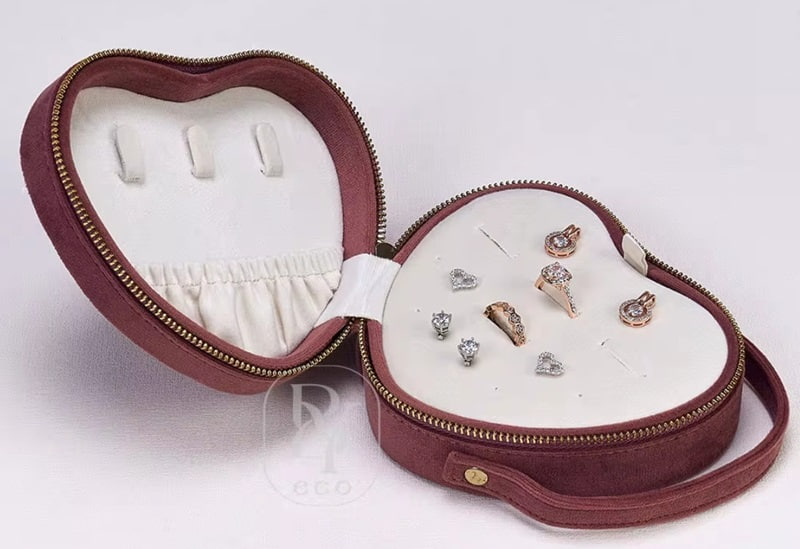You can share
- Share to Facebook
- Share to Google+
- Subscribe to our
- Share to Linkedin
- Share to Twitter

High-end jewelry packaging boxes are not only the protective shell of the product, but also the physical expression of brand value. However, facing the dual challenges of rising global raw material prices and escalating consumer environmental protection demands, how to control costs while maintaining a luxurious texture has become a compulsory course for jewelry brands. This article disassembles the core strategies of reducing costs and increasing efficiency from six dimensions: material innovation, process optimization, and supply chain integration.
Traditional high-end jewelry boxes often fall into the misunderstanding of "overpackaging": multi-layer solid wood nesting, pure hand-made gilded relief, imported velvet lining... Although these designs are noble, the cost accounted for as high as 15%-20% of the product price. The new generation of consumers pays more attention to the balance between functional experience and emotional value, which provides a breakthrough for cost optimization.
Case:
Cartier switched to recyclable kraft paper boxes with magnetic opening and closing structures, reducing costs by 40%, but won the 2023 Pentawards Packaging Gold Award with its minimalist design.
Domestic designer brand YIN launched a "growing" pulp packaging box. The interactive experience of planting plants transforms packaging costs into social communication value.
(1) Basic material replacement solution
Solid wood (such as black walnut) can be replaced by FSC-certified recycled cardboard + wood grain coating, which can reduce costs by 60%
(2) Key technological innovation
Micro-foaming paper plastic technology: Inject gas during the pulp molding stage to form a sponge-like structure, which increases the cushioning performance of the paper box by 3 times and reduces the thickness by 30%.
Digital printing replaces hot stamping: Using high-precision UV printing technology to achieve metallic luster, embossed touch, and other effects, the cost of small batch orders is reduced by 50%.

(1) Modular combination design
Basic box type standardization: The packaging box is decomposed into three modules: cover, lining, and outer cover, and customized by replacing accessories (such as waist seal and tag). Tiffany's classic blue box has achieved 85% commonality of parts.
Flat-plate prefabrication + self-assembly: delivered in flat-plate form, folded and formed in 3 minutes at the terminal store, reducing logistics costs by 35%.
(2) Strategy of reducing quantity without reducing quality
Single-layer lining replaces multi-layer nesting: use EVA foam with grooves to form a one-piece lining, and achieve single-layer fixation by calculating the center of gravity distribution of the jewelry. Bulgari Serpenti series snake-shaped bracelet box uses this design, reducing the lining cost by 62%.
Hidden lock replaces metal hinge: PP plastic lock tongue is embedded in the paper box body when the mold is opened, and the opening and closing life is more than 5,000 times, and the hinge cost is zero.
(1) Combination punch to reduce costs in the production process
Centralized nesting cutting: optimize the cutting path of cardboard and wood through AI typesetting software, and the material utilization rate is increased from 68% to 92%.
Low-temperature curing process: change the traditional high-temperature baking of ink (150℃×30 minutes) to UV-LED low-temperature curing (40℃×10 seconds), reducing energy consumption by 70%.
(2) Equipment upgrade ROI model
Take the purchase of a $300,000 digital die-cutting machine as an example:
Reduce die-cutting costs: save 300,000 yuan per year
Increase production speed: average daily output +2,000 pieces
Shorten delivery cycle: from 45 days to 20 days
→ Investment payback period is only 14 months
(1) Cross-brand joint procurement
Establish a jewelry packaging material procurement alliance, increase the order volume to more than 3 times the supplier's minimum economic batch (MOQ) through group orders, and increase bargaining power by 20%-30%.
Case: LVMH Group's Chaumet, FRED, and other brands jointly purchase environmentally friendly inks, reducing the unit price by 18%.
(2) Regionalized production clusters
Packaging plants are deployed around jewelry industry belts (such as Shuibei, Shenzhen, China, and Valenza, Italy) to achieve:
Transportation radius ≤ 200 kilometers, logistics costs reduced by 40%
Proofing response speed has been shortened from 7 days to 24 hours
Reducing the cost of high-end jewelry packaging boxes is not simply cutting the budget, but through the triple transformation of material science, design thinking, and supply chain innovation, every investment is converted into consumer-perceivable value. When packaging evolves from a "cost center" to an "experience engine", high-end jewelry brands can jump out of price involution and walk elegantly on the balance beam of quality and profit.